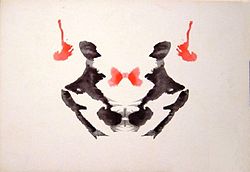Rorschach test
The Rorschach test is a psychological test in a form of inkblots on the cards. It is still used. It was named after Swiss psychologist Hermann Rorschach.
The test determines the state of patients and their problems.
History
Herman Rorschach was not the first who invented this method. Interpretation of inkblots was used in the game Gobolink from the late 19th century.[1] In Europe such games were known as kleksography.[1]
Then Alfred Binet appeared. He first used it for psychological research. It determined the work of the imagination and consciousness.
In 1921, Rorschach wrote his main book Psychodiagnostik where he described the test.
Also Austrian psychologist SIgmund Freud showed how psychic expressions of the individual (in speech, dreams, and so on) could be read as signs pointing to unconscious processes. These processes were significant for a fuller and deeper understanding of his personality. Finally, Freud stressed the very earliest experiences of the child in the family as of primary significance in the moulding of personality.[2]
Similar tests have been devised by American psychologist Wayne H. Holtzman.
Later the test began to be used in all sorts of speculative ways. Researchers gave the test to Nazi criminals during Nuremberg Trials hoping to find out the psychological roots of mass murder.[3]
Method
Rorschach showed inkblots to many people with the same question: "What might this be?". It showed how people approached the task. It showed also a different perception of people. Some people saw the movement on the pictures, some not.
Usually inkblots pictures are shown secretly to make the patients' responses spontaneous.
In mass culture
Rorschach test is used in many films, TV series, books, comics.
- One of the main character in comic book Watchmen is named after Rorschach. Rorschach also passed the Rorschach test.
- Andy Warhol created Rorschach Paintings displayed in the Baltimore Museum of Art.[4]
Rorschach Test Media
Hermann Rorschach created the inkblot test in 1921. (Photo from c. 1910)
Related pages
References
- ↑ 1.0 1.1 Richardson, John T. E. (2011-11-29). Howard Andrew Knox: Pioneer of Intelligence Testing at Ellis's Island. Columbia University Press. ISBN 978-0-231-51211-4.
- ↑ Hallowell, A. Irving (1945). "The Rorschach Technique in the Study of Personality and Culture2". American Anthropologist. 47 (2): 195–210. doi:10.1525/aa.1945.47.2.02a00010. ISSN 1548-1433. Archived from the original on 2021-07-20. Retrieved 2021-07-20.
- ↑ EDT, Douglas Main On 9/7/15 at 3:31 PM (2015-09-07). "Nazi Criminals Were Given Rorschach Tests at Nuremberg". Newsweek. Retrieved 2021-07-20.
- ↑ Bushey, Michael A. (2015). "Rorschach Inkblot Invasion of Pop Culture". American Journal of Psychiatry. 172 (10): 949. doi:10.1176/appi.ajp.2015.15040519. ISSN 0002-953X. PMID 26423480.










